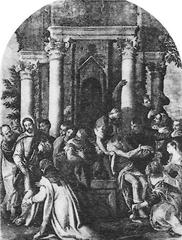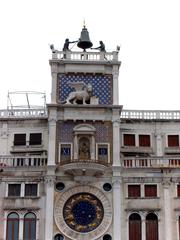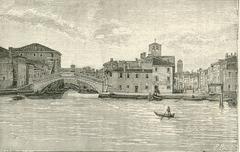
Chioggia Unveiled: A Quirky Local’s Guide to the Other Venice
Date: 04/07/2025
Unlock Chioggia: Where Salty Air Meets Surprising Secrets
Imagine starting your morning with a sunlit espresso overlooking a canal where candy-colored fishing boats bob in the gentle breeze. The air carries the aroma of fresh seafood and the sound of lively dialects, while locals trade jokes and legends as easily as they trade fish. Welcome to Chioggia—a town whose ancient roots reach further back than Venice’s, brimming with playful pride and rich tradition. Here, every bridge tells a story, every market stall hides a legend, and every nonna guards a secret recipe—usually featuring more shellfish than you thought possible (Islands.com; Visit Chioggia).
While Venice is often crowded and bustling with tourists, Chioggia offers a more intimate experience: a living tapestry of salt-kissed history, feisty locals with legendary nicknames, and a culinary scene as vibrant as the town itself. Amble through the iconic fishbone-patterned streets, marvel at the world’s oldest working astronomical clock, and taste specialties like pumpkin gnocchi made from the famed Zucca Marina di Chioggia. Touch the timeworn Murazzi sea walls, breathe in the briny air, and listen as fishermen greet the dawn with song (European Waterways).
But don’t be fooled—Chioggia is no mere “Venice Lite.” With communal nicknames (“detti”) so vital they appear on ID cards, and festivals that fill Corso del Popolo with seafood, music, and light-hearted antics, Chioggia stands proudly apart. The sea shapes everything here, from the daily menu to the dialect, infusing each day with a sense of adventure and authenticity (Inside Europe).
This guide is your passport to Chioggia’s secrets—told with the wit and warmth only locals can offer. So pack your sense of humor, a phrasebook, and maybe a raincoat (for mischievous seagulls). Let’s start exploring.
Table of Adventures: What Awaits You
Ancient Origins and Roman Foundations
Chioggia’s story stretches deep into antiquity, predating Venice itself. Archaeological finds suggest settlement as early as the 2nd century BCE, making Chioggia one of the oldest continually inhabited towns in the Venetian Lagoon (Islands.com). Known as Clodia in Roman times—a name cited by Pliny the Elder—the town’s main roads still follow the classic Roman grid of cardo and decumanus (Visit Chioggia).
During the Roman era, Chioggia’s strategic position at the southern edge of the lagoon made it vital for trade and maritime activities. Salt production formed the backbone of its early economy, so essential that it became a state-controlled asset in later centuries (Visit Chioggia).
Early Medieval Survival and Autonomy
The fall of the Western Roman Empire brought waves of invasions to northern Italy, but Chioggia endured, shielded by its lagoon setting. By the 6th century CE, it was part of the Byzantine Empire, serving as a fortified outpost with a degree of autonomy (Wikipedia). Its name evolved through the ages—Clodia, Cluza, Clugia, Chiozza, and, finally, Chioggia—mirroring the town’s layered history and shifting rulers.
The Rise of the Salt Industry & Venetian Ties
By the early Middle Ages, Chioggia’s salt pans had made it a regional powerhouse. The salt harvested here was so prized that the emerging Venetian Republic worked to control both its production and trade (Visit Chioggia). In the 11th century, Chioggia became a free commune and an episcopal see, underscoring its growing importance. The cathedral dedicated to St. Mary of the Assumption traces its roots to this period, later rebuilt in the 17th century by Baldassare Longhena (Wikipedia).
The War of Chioggia: A Defining Conflict
Chioggia played a pivotal role in the War of Chioggia (1378–1381), a fierce struggle between Venice and Genoa for control of Mediterranean trade. Genoese forces seized Chioggia in 1378, threatening Venice itself. After months of siege, Venetians recaptured the town in 1380, shifting the war’s momentum and cementing Venice’s dominance in the Adriatic (Wikipedia). Remnants of this era are still visible in the town’s fortifications and the Fort of San Felice (Visit Chioggia).
Integration with the Venetian Republic
Following the war, Chioggia maintained a degree of autonomy but was firmly under Venice’s influence. In the 15th century, Venice tightened its grip, monopolizing the salt trade and integrating Chioggia into its maritime empire (Wikipedia). Despite this, the chioggiotti preserved their distinct identity, dialect, and customs (Inside Europe).
Urban Development and Architectural Heritage
Chioggia’s unique “fishbone” layout—with canals running parallel to the main street and narrow calli crossing at right angles—reflects both its Roman roots and Venetian influence (Visit Chioggia). The medieval churches, including San Domenico and Sant’Andrea, display a blend of Romanesque, Byzantine, and Baroque styles. The bell tower of Sant’Andrea houses one of the world’s oldest working tower clocks (European Waterways).
Sottomarina: Chioggia’s Twin
Sottomarina, now a lively seaside district, began as Clodia Minor in the 7th century. Originally a fishing village, it evolved into a beloved beach resort. The Murazzi, an 18th-century stone dam built by Venice, protects the area from the sea’s encroachment (Visit Chioggia).
Economic and Cultural Significance
Chioggia’s fortunes have always been tied to the sea. Today, fishing remains central, with the port ranking among Italy’s largest. The renowned fish market preserves centuries-old traditions (Britannica). Shipbuilding, brickmaking, and the import of Istrian stone also shaped the local economy.
Culturally, Chioggia is celebrated for its bobbin lace—distinct from Burano’s needle lace. Festivals, open-air markets, and a cuisine rich in seafood offer a vivid taste of authentic lagoon life (Visit Chioggia).
Literary and Artistic Legacy
Chioggia has long inspired artists and playwrights. Carlo Goldoni’s comedy “Le baruffe chiozzotte” (“The Chioggia Scuffles”) captures the vivacious spirit of its locals and remains a classic of Italian theater (Wikipedia).
Modern Era and Preservation
Often called “Little Venice,” Chioggia’s historic core, canals, and colorful facades are carefully preserved, forming part of the UNESCO-protected Venetian Lagoon (Inside Europe). The town’s 50,000 residents are split between the old center and Sottomarina (Wikipedia). Chioggia’s layered history, unbroken connection to the sea, and vibrant local culture create a compelling alternative to overcrowded Venice.
Chioggia: Venice’s Cheeky Sibling
Sunlight sparkles on a patchwork of boats, the smell of scallops drifts through the air, and a seagull cackles as if it knows the town’s best secrets. This is Chioggia—a place where life follows the tides and laughter comes as easily as the catch.
Canal Journey Through History
Chioggia, the lagoon’s lively “little sister,” predates Venice and boasts an eventful past—from Byzantine outpost to Venetian ally (and sometimes rival). The town’s layered history is reflected in its architecture, spirited festivals, and proud locals.
Local’s Tip: Begin with a stroll down Corso del Popolo. Hunt for the smallest bridge and count the lion statues on the porticoes—you’ll spot more than you expect!
Nicknames, Lingo, and Local Quirks
Here, nearly everyone is named Boscolo or Tiozzo. To keep families straight, locals use “detti” (nicknames) like Boscolo “Pupa” or Tiozzo “Cavallo”—so important they’re officially listed on ID cards. Try asking a fishmonger for their detto; if you can repeat it back, you’re practically a local.
Speak Like a Chioggiotto
- Xe tuto a posto? – Is everything okay?
- Baruffa – A lighthearted quarrel (see Goldoni’s play)
- Cicchetto – Venetian snack (or a shot of grappa)
- Mògnolo – Fishmonger (pronounced “MOH-nyo-lo”)
Pro tip: Never order a cappuccino after 11am unless you want a raised eyebrow.
Where the Sea Sets the Rhythm
The sea shapes daily life. At dawn, the fishing fleet sails out; by midday, the fish market buzzes with dialects and the scent of brine. The canals resemble Venice, but with space for bicycles and the occasional moped. For a quieter moment, slip away to Fondamenta Merlin at sunset or enjoy sarde in saor at a hidden bacaro.
Festivals and Local Life
Every July, the Sagra del Pesce transforms Corso del Popolo into a seafood-lover’s dream. Expect mountains of fried calamari, flowing wine, music, and the occasional dance-off. Winter’s Festa della Madonna della Navicella sees miniature boats blessed on the canals, while spring brings rowing regattas with fierce, friendly competition.
Goldoni’s “Le Baruffe Chiozzotte” immortalizes this feisty spirit, and if you look closely, you’ll spot Chioggia in European films and novels.
Eat, Drink, and Celebrate
Chioggia’s cuisine is legendary—think fish brodo, risotto alla pescatora, seafood bigoli, and pumpkin gnocchi made with local Zucca Marina. Snack on cicchetti with local wine at a canal-side bar, and don’t be shocked if a seagull tries to swipe your treat.
Wander, Wonder, and Savor
Chioggia is made for slow exploration. Lose yourself among pastel streets, peek into ancient churches, and watch fishermen mend their nets. Here, there are no crowds—just stories waiting to be discovered.
Etiquette and Practical Tips
- Greet shopkeepers with “Buongiorno!”
- Take your time over meals—life here is unhurried.
- Decline grappa at your own risk—it’s considered bad luck!
- Cappuccino after lunch? Only if you want to stand out.
Quick FAQs
Can I get around by boat?
Absolutely—take a vaporetto or hire a bragozzo for a classic experience.
Is English spoken?
In tourist spots, yes. But a few words of dialect go a long way.
Best photo spot?
Ponte Vigo at sunset or Calle Zitelle for colorful doors.
Best souvenir?
Something with Zucca Marina di Chioggia or a hand-painted ceramic fish.
Thematic Itinerary: Chioggia’s Treasure Map
The Fisherman’s Labyrinth
- Start at Canal Vena, counting boats with painted eyes. Snap a photo with a fisherman named Gigi if you find him.
- Pause at the Pescheria and ask for the weirdest recipe in the market.
The Secret Society of Arcades
- Join the evening passeggiata on Corso del Popolo and sample the town’s best pastries.
- Find the narrowest alley (“calle”) and try to touch both sides.
The Bell Tower Time Machine
- Climb Torre di Sant’Andrea and listen for the ancient clock, dating from 1386.
- On the top floor, play “I Spy” with the lagoon islands.
Chioggia by the Senses
- See: Laundry flapping above the canals, the grandeur of Cattedrale di Santa Maria Assunta.
- Smell: Salty air, fresh focaccia, and the tang of fish at the morning market.
- Hear: Market chatter, dialects, and the occasional fisherman’s song.
- Taste: Radicchio, spaghetti alle vongole, and cicchetti.
- Touch: Ancient Murazzi sea walls and the warm sand at Sottomarina.
Local Legends and Hidden Corners
- San Domenico Church: Cross the bridge and look for sailor ex-votos. Ask about the rumored tunnel to the old salt warehouses.
- Ca’ Roman Nature Reserve: Ideal for a scenic picnic and birdwatching.
- Thursday Market: Enjoy the parade of local fashion and personalities.
Say It Like a Local
- Ciao, fioi! – Hi, kids! (to all ages)
- ‘Na ombra de vin? – Fancy a glass of wine?
- Se magna ben! – You eat well here!
- Dove xe el bagno? – Where’s the bathroom?
Do’s & Don’ts
- Do: Join the evening passeggiata.
- Don’t: Ask if the fish is from Venice!
- Do: Try local “bussolai” cookies.
- Don’t: Ask for ketchup.
- Do: Greet nonnas—they run the place.
Sample Day: Choose-Your-Own-Adventure
Morning: Wander the fish market and sample pastries with locals.
Midday: Climb the clock tower, then enjoy seafood pasta at a trattoria.
Afternoon: Relax on Sottomarina beach or explore Ca’ Roman.
Evening: Aperitivo by the canal, then dinner with cicchetti and a sunset view.
Ready to Roam? Discover Chioggia’s Wonders with Audiala
As dusk gilds the canals, you’ll realize Chioggia isn’t just another Venetian outpost—it’s a living celebration of lagoon life (Britannica). Here, every corner invites you to slow down, savor, and join the story. From ancient Roman grids to the echoes of the War of Chioggia, and from lively markets to hidden alleyways, Chioggia rewards curiosity and playfulness. Many leave convinced that Venice is the copy and Chioggia the original masterpiece (Wikipedia; Visit Chioggia).
Want even more? Download Audiala for immersive audio guides, secret stories, and local legends—making every stroll a true adventure. See Chioggia not as a tourist, but as a chioggiotto at heart.
Sources
Audiala2024







